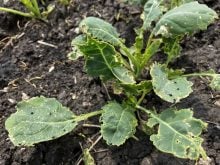A recent change may have a seismic effect on wheat and durum growers across Western Canada.
In December 2020, the Pest Management Regulatory Agency issued an update on the re-evaluation of the insecticide chlorpyrifos, announcing that chlorpyrifos would be phased out as follows:
- Last date of sale by registrant: Dec. 10 2021
- Last date of sale by retailers: Dec. 10 2022
- Last date of use for all chlorpyrifos products: Dec. 10 2023
This is a big deal is because chlorpyrifos (Lorsban, Pyrinex, NuPhos, Citadel and others) will not be available for controlling wheat midge this year unless you have product on your farm. And it will not be legal to use these products in following years. This leaves Canadian farmers with no effective insect control product for the control of midge in the upcoming years.
Let’s roll back the calendar to the early 1980s. Many of you reading this weren’t even born then.
Wheat growers in northeastern Saskatchewan and the Swan River region of Manitoba were noticing wheat yields were very poor in otherwise healthy looking stands. In 1983, orange wheat blossom midge, also known as sitodiplosis mosellana, was identified as the likely culprit for the damage.
Federal and provincial governments and industry partners worked to identify a solution. As a result, two products were registered for the control of wheat midge in Canada: chlorpyriphos and dimethoate. When tested, these products gave effective control of wheat midge adults and had pre-harvest intervals that would allow for their use at the proper stage and acceptable residues in the grain at harvest.
However, only chlorpyriphos proved to be effective at reducing yield losses and quality reduction. It has the additional property of destroying midge eggs that have been laid in wheat heads up to approximately five days earlier.
Because the majority of midge adults emerge over seven to 10 days, a timely application of chlorpyrifos is effective at controlling not only the adults but also the eggs that have been laid over the past few days.
While highly effective in controlling many insects, such as grasshoppers, aphids and lygus bugs, dimethoate does not have this property. It only controls the adults that are in the field when the application is made.
I recall being involved in farmer-applied field trials during the early midge years when I worked for the manufacturer of Cygon, a dimethoate product. The trials we carried out showed that, while Lorsban reduced kernel damage and increased yield, Cygon sprayed the same day with the same equipment showed little or no impact on either parameter. My recommendation for wheat midge control is that you cannot rely on dimethoate to provide a yield improvement or reduce kernel damage from wheat midge.
So, without one of the major tools in our tool box, how do we manage wheat midge? Luckily, we have developed two other effective control technologies.
It was observed that early seeded spring wheat and durum were usually beyond the susceptible stages for wheat midge damage when adult midges emerged in July. In general, HRSW planted prior to 100 growing degree days (GDD) will head before wheat midge emerge, HRSW planted from 100 to 300 GDD will be heading at the time wheat midge are emerging and HRSW planted after 300 GDD will head after peak emergence and should be at low risk to infestation.
Planting wheat early has become the effective norm in areas where wheat midge is an issue. However, there is always a competition for early planting with crops such as peas. And years such as 2022 come along when most of Manitoba and eastern Saskatchewan were delayed to the point that much of the early wheat was planted after May 21.
The second control method is planting wheat varieties that contain the single gene (Sm1), which provides resistance and was first identified in winter wheat.
Midge tolerant wheat varieties protect growers from damage caused by the orange wheat blossom midge, which can result in grade and yield losses. Seed is sold as a varietal blend, with 90 percent made up of a midge tolerant variety and the remaining 10 percent midge susceptible.
Currently, there are varieties available in most wheat classes including CWRS, CPSR, CWSWS, CNHR, CWSP, CWES, CWHWS and CWAD. This year, there is also a variety of CWRS wheat that has both Clearfield tolerance and midge tolerance.
My recommendation for 2023 would be to take a look at your provincial wheat midge forecast maps. Alberta’s shows a hot spot southwest of Edmonton, while Saskatchewan has a number of hot spots, including a large area of concern running between Highway 2 on the west and Highway 35 on the east. No map is available for Manitoba.

If you were in an elevated risk area (yellow or worse), I would seriously consider growing a midge tolerant wheat variety in 2023, at least on some of your fields.
I would suggest that you seed the latest planted acres to one of these varieties. Your usual planting date for wheat will help determine whether it is the last half or the last third of your acres. There would be nothing wrong with planting all your acres to a midge tolerant variety.
If you farm in an area of lower risk, consider planting some midge tolerant wheat to increase seed for 2024. The wheat midge risk maps show an increase in the areas of higher risk, so it may be coming to an area near you.
Remember that the stewardship agreement for midge tolerant wheat limits the use of farm-saved seed to one generation past certified seed. This will ensure that the risk of wheat midge developing resistance to the Sm1 gene is minimized. However, by growing enough seed for two years, it will allow you to use farm-saved seed for an extra year.
Also consider that at least 25 millimetres of precipitation prior to the end of May is required for proper development of the wheat midge. Lower levels of moisture reduce emergence of adults. We tend to see lower risk in areas following a dry year.
In much of southwestern and west-central Saskatchewan and central and southern Alberta, we continue to experience much lower than average rainfall, which might reduce the risk of wheat midge.


















